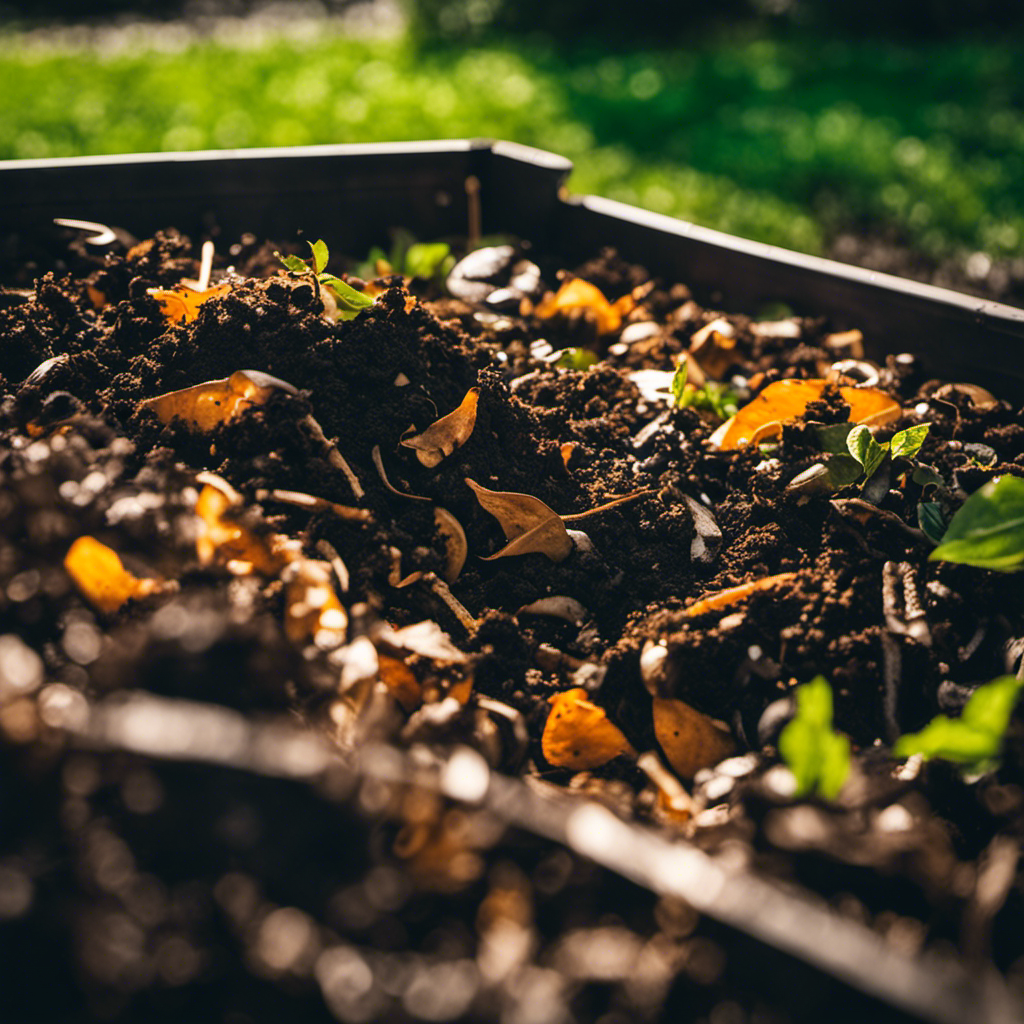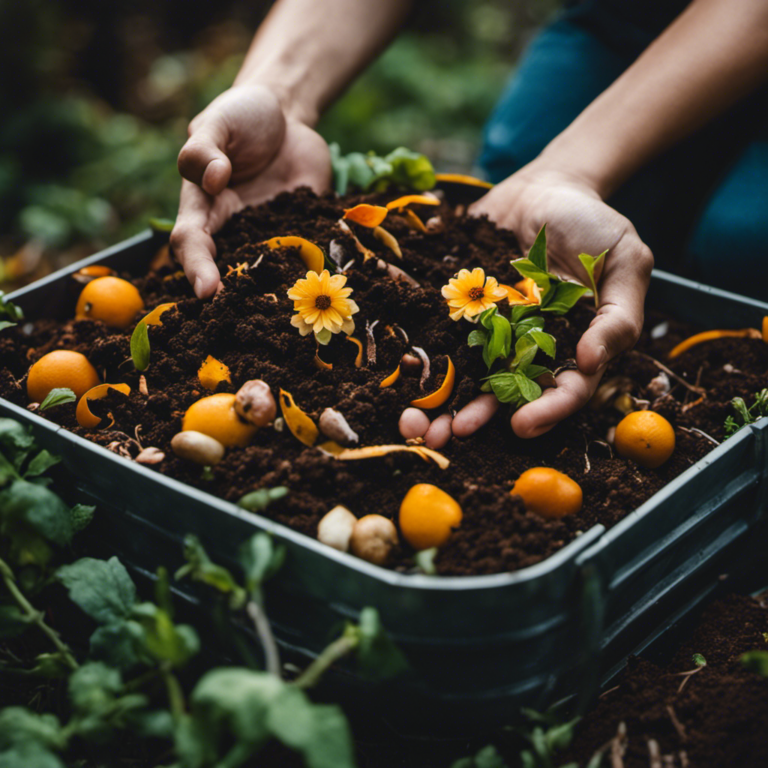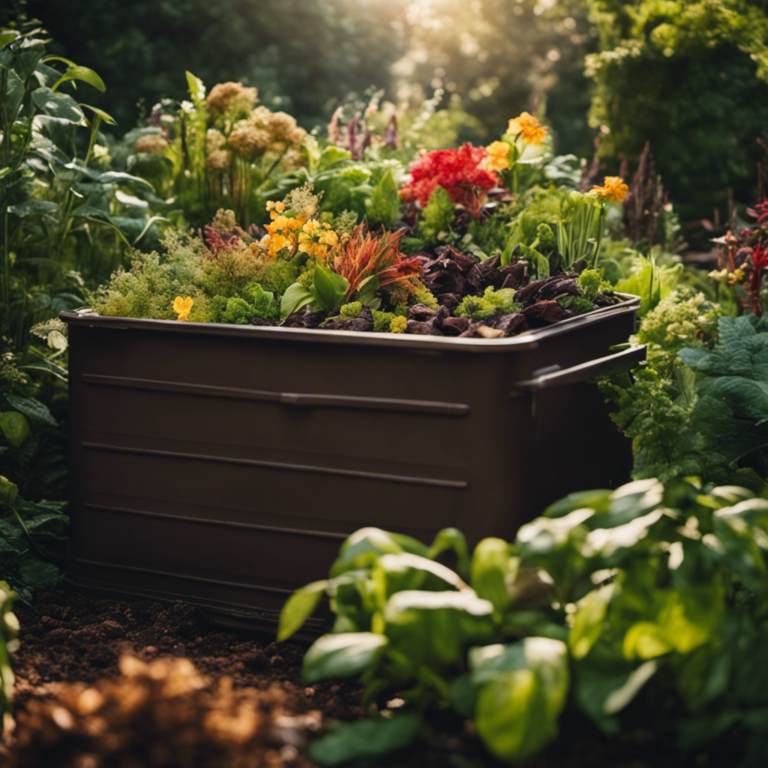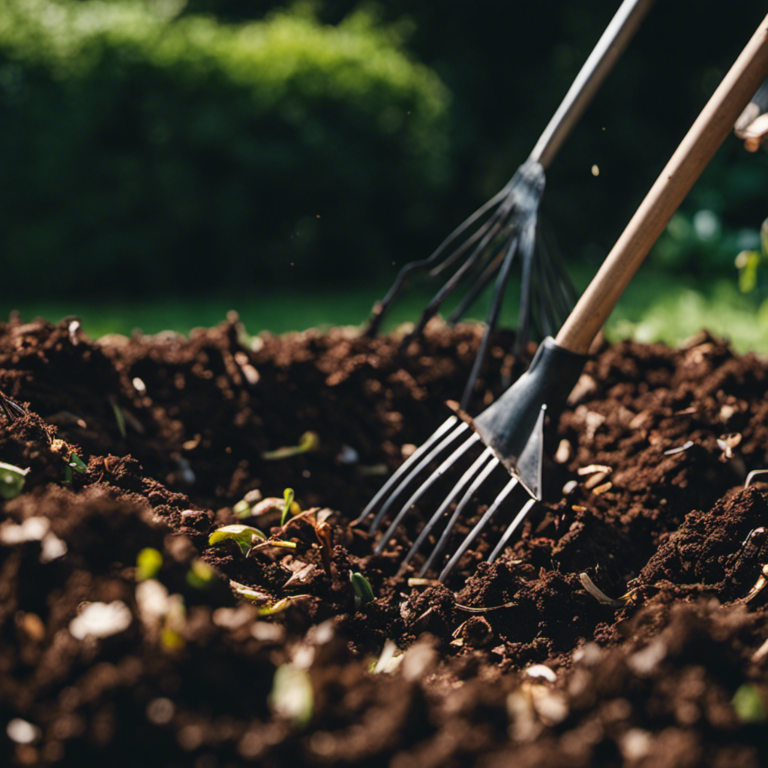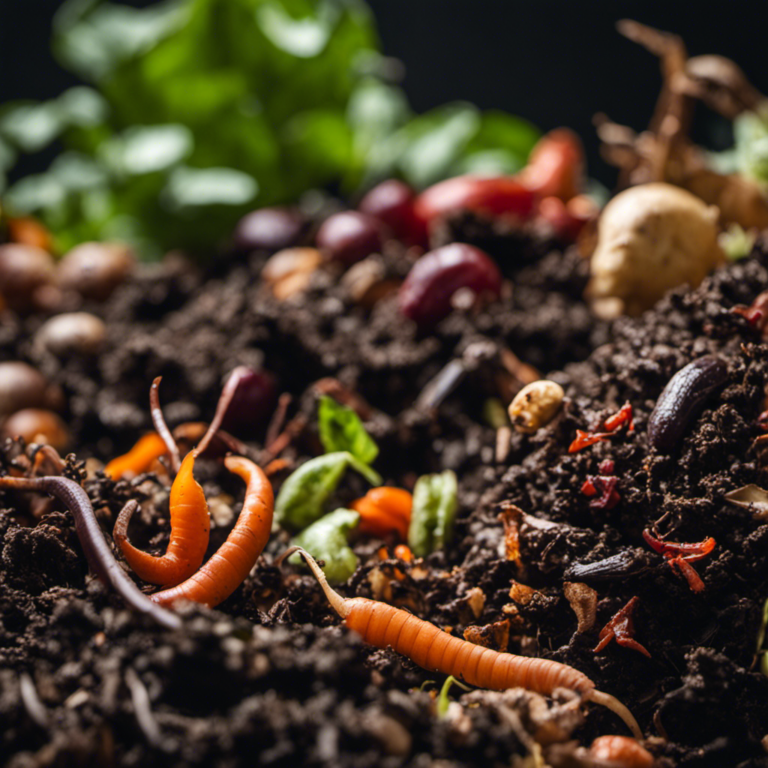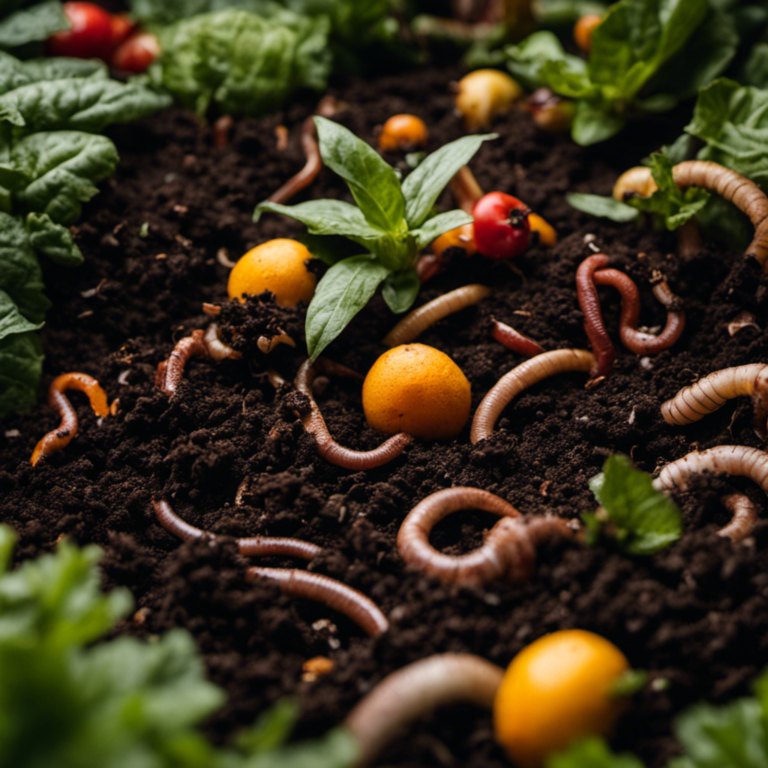Looking to start composting but not sure where to begin? Well, you’re in luck! I have 10 easy organic composting methods that are perfect for beginners like you.
With just a few simple steps, you can transform your kitchen scraps, yard waste, and even coffee grounds into nutrient-rich soil for your plants.
So why wait? Let’s get started and learn how you can make a positive impact on the environment while creating a thriving garden at the same time.
Key Takeaways
10 Simple Methods for Organic Composting Beginners
Organic composting is an easy and effective way to turn kitchen scraps, yard waste, and other organic materials into nutrient-rich soil for your plants. Instead of relying on chemicals or artificial fertilizers, you can use natural methods to create a healthy environment for your garden.
Two popular composting techniques are vermicomposting, which involves using worms, and bokashi composting, which utilizes an airtight container. These methods help reduce waste and offer a sustainable solution for gardening.
So why not give it a try? With these composting methods, you’ll be on your way to successful gardening, just like a busy bee pollinating flowers.
Basic Composting With Kitchen Scraps
Composting kitchen scraps is a simple and effective way to reduce waste and create nutrient-rich soil for your garden, even if you have limited space.
One method you can try is creating a small compost bin using a plastic container. This allows you to compost in small spaces like a balcony or a small backyard.
To get started, find a plastic container with a lid that’s at least 18 inches deep. Make sure it has drainage holes on the bottom to allow excess moisture to escape. Collect your kitchen scraps, such as fruit and vegetable peels, coffee grounds, and tea bags. Avoid adding meat, dairy, and oily foods as they can attract pests.
To enhance the composting process, you can add crushed eggshells to the bin. Eggshells are rich in calcium and help balance the pH level of the compost. They also act as a natural pest deterrent. Remember to crush the eggshells before adding them to the bin to speed up their breakdown.
Place the plastic container in a sunny spot and remember to turn the contents regularly to aerate the compost. Keep the compost moist, but not overly wet, by adding water as needed.
In just a few months, you’ll have rich, dark compost that can be used to nourish your plants and reduce your carbon footprint.
Happy composting!
Vermicomposting With Worms

I’ve always been fascinated by the concept of using worms for composting, also known as vermicomposting. Not only is it a convenient method for disposing of kitchen scraps, but it also offers numerous benefits for the garden.
Vermiculture improves soil fertility, increases microbial activity, and reduces waste.
If you’re interested in starting vermicomposting, there are a few important things to know.
Worms for Composting
To get started with vermicomposting using worms, I recommend using a dedicated worm bin. This will create a controlled environment for the worms and make managing the composting process easier.
Here are four important factors to consider when using worms for composting:
-
Choose the right worms: The most commonly used worms for vermicomposting are Eisenia fetida, also known as red wigglers. These worms are efficient at breaking down organic waste and thrive in controlled environments.
-
Feed the worms properly: Worms require a balanced diet consisting of kitchen scraps, yard waste, and shredded paper. Avoid feeding them meat, dairy products, or oily foods as these can attract pests and create unpleasant odors.
-
Maintain optimal conditions: Keep the worm bin in a cool and shady area, as worms prefer temperatures between 55-77°F (13-25°C). Ensure proper moisture levels by adding water when necessary, but avoid overwatering as it can drown the worms.
-
Harvest worm castings: After a few months, the worms will have transformed the organic waste into nutrient-rich worm castings. To harvest the castings, simply move the contents of the bin to one side and add fresh bedding and food to the other. The worms will migrate to the new side, allowing you to collect the castings.
Benefits of Vermiculture
The benefits of vermiculture are clear after considering important factors such as worm selection and optimal conditions.
Vermiculture, also known as vermicomposting with worms, offers several advantages for organic gardeners and those looking to lessen their environmental impact.
One of the main benefits is the production of high-quality compost that’s rich in nutrients. The worms break down organic material into nutrient-rich castings, which can be used to enhance soil health and fertility.
Additionally, vermiculture helps reduce waste by diverting organic matter from landfills. This sustainable and eco-friendly method allows for the recycling of kitchen scraps and yard waste.
Furthermore, vermiculture techniques are easy to implement and require minimal space and equipment.
Getting Started With Vermicomposting
Getting Started With Vermicomposting
Here’s a simple guide on how to start vermicomposting using worms:
-
Choose a suitable bin: Find a container that can hold your compost and has drainage holes for excess moisture.
-
Prepare bedding material: Use shredded newspaper, cardboard, or coconut coir as bedding for the worms. Dampen it slightly to create a moist environment.
-
Add the worms: Purchase redworms or Eisenia fetida worms specifically for vermicomposting. Start with a small amount and gradually increase as the population grows.
-
Feed the worms: Offer a balanced diet of fruit and vegetable scraps, coffee grounds, tea leaves, and crushed eggshells. Avoid meat, dairy, and oily foods.
Vermicomposting offers numerous benefits, including waste reduction, production of nutrient-rich compost, and improved soil health. By following these steps, you’ll be on your way to a successful vermicomposting setup in no time.
Happy composting!
Leaf Composting in a Backyard Pile

Leaf composting in a backyard pile is a simple and cost-effective method for organic composting. It offers numerous benefits, making it an excellent option for gardeners who want to support their plants and the environment.
Using fallen leaves in your yard for composting is a convenient and eco-friendly way to repurpose them. Instead of throwing them away and contributing to landfill waste, you can transform them into nutrient-rich compost. This compost won’t only nourish your plants but also improve the overall health of your soil.
One of the main advantages of leaf composting is waste reduction. By composting your leaves, you’re diverting them from the waste stream and giving them a valuable second life as organic matter. This not only helps reduce landfill space but also decreases greenhouse gas emissions associated with decomposition.
Leaf compost also serves as a natural fertilizer, providing essential nutrients to your plants. It enhances soil structure, promoting better water retention and aeration. This leads to healthier plants with stronger root systems, making them more resistant to pests and diseases.
To start leaf composting in your backyard, simply gather the fallen leaves and create a pile in a designated area. It’s important to shred the leaves to speed up the decomposition process. You can use a lawnmower or a leaf shredder for this purpose. Adding kitchen scraps or green waste to the pile will supply nitrogen, which helps balance the carbon-to-nitrogen ratio.
Keep the pile moist, but not overly wet, and turn it regularly to ensure proper aeration. Within a few months to a year, depending on the conditions, your leaf compost will be ready to use in your garden.
Bokashi Composting in an Airtight Container
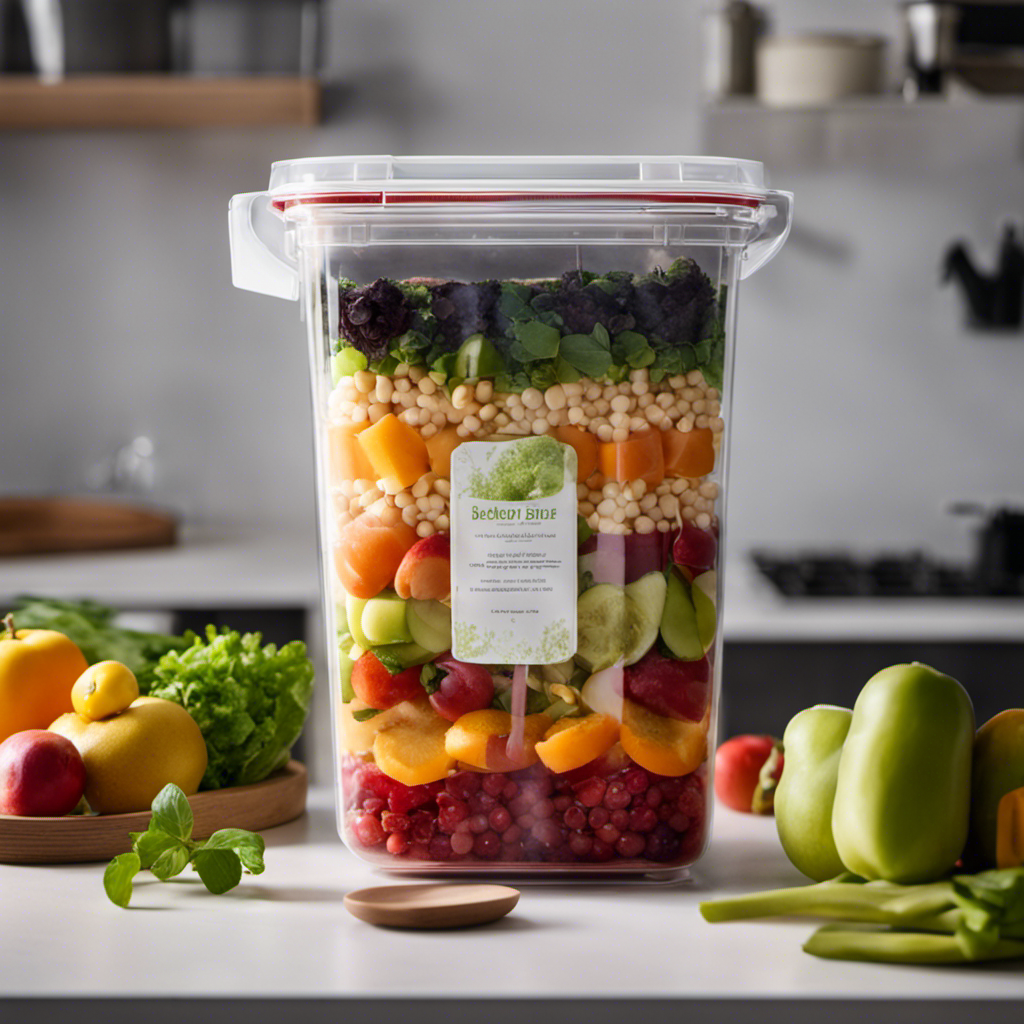
When it comes to organic composting methods, one technique that beginners can explore is bokashi composting in an airtight container. This method provides several benefits and is a simple process to follow.
Here are four reasons why bokashi composting in an airtight container is worth considering:
-
Odor control: The airtight container used in bokashi composting prevents the release of unpleasant smells, making it an ideal option for those living in urban areas or with limited outdoor space.
-
Speedy decomposition: The bokashi composting process utilizes a mix of beneficial microorganisms that ferment organic waste. This fermentation process speeds up decomposition, allowing for quicker compost production compared to traditional methods.
-
Variety of materials: Unlike other composting techniques, bokashi composting allows for the inclusion of a wider range of organic waste, including meat, dairy, and citrus peels. This versatility makes it easier to divert a larger portion of household waste away from the landfill.
-
Rich compost tea: Another advantage of bokashi composting is the production of nutrient-rich compost tea. This liquid byproduct can be diluted and used as a natural fertilizer for plants, promoting healthy growth and reducing the need for chemical additives.
Composting With Coffee Grounds
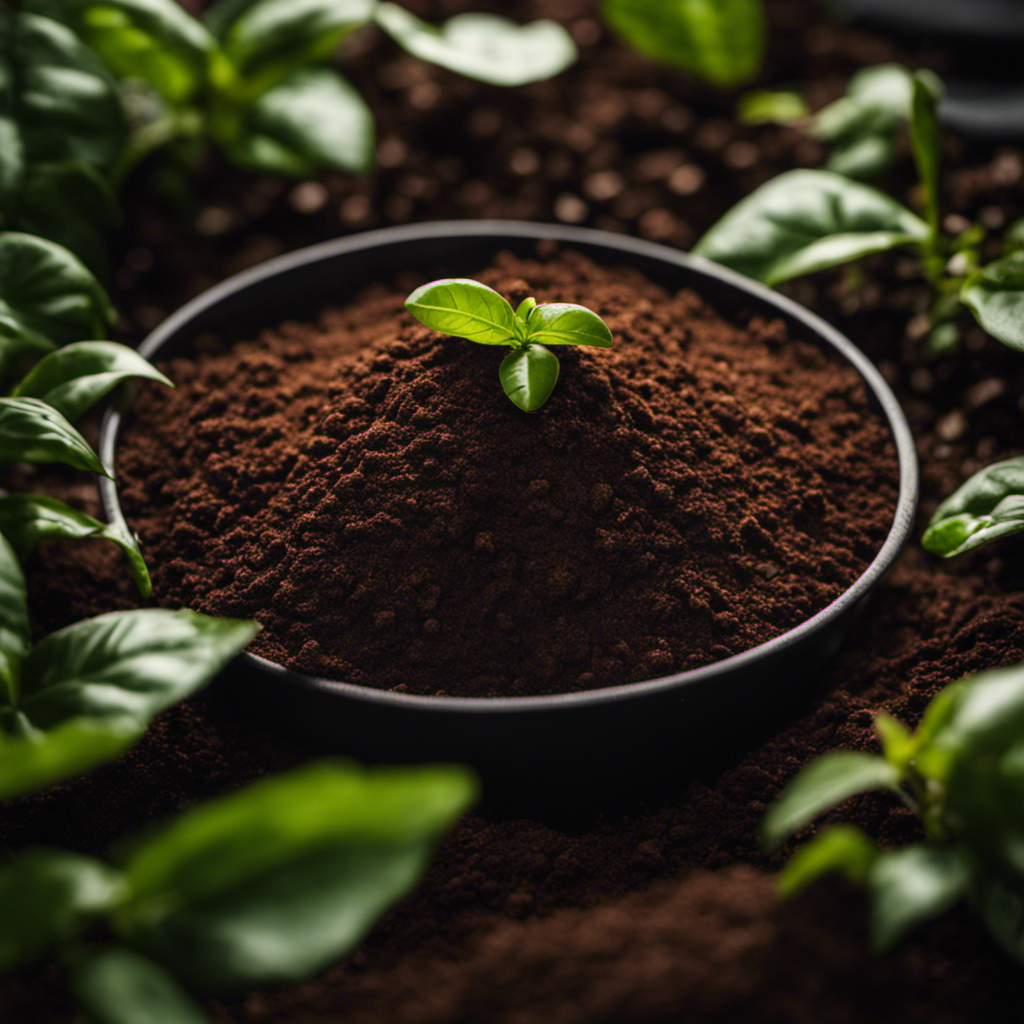
Composting With Coffee Grounds
If you’re new to composting and looking for an easy and effective method, consider composting coffee grounds. Not only is it a convenient way to dispose of used coffee grounds, but it also offers many benefits for your garden.
Coffee grounds are packed with nitrogen, an essential nutrient for plant growth. When added to your compost, they help increase the overall nitrogen content, promoting healthy foliage and growth. Additionally, coffee grounds contain other minerals like potassium, calcium, and magnesium, which are beneficial for plant development.
To start composting coffee grounds, simply collect your used grounds and add them to your compost pile or bin. Remember that coffee grounds are considered "green" or nitrogen-rich material, so it’s important to balance them with "brown" or carbon-rich materials like dried leaves or shredded paper.
To better understand the benefits of coffee grounds in compost, here’s a table comparing their nutrient content to other compostable materials:
| Material | Nitrogen Content | Carbon Content |
|---|---|---|
| Coffee Grounds | High | Low |
| Tea Leaves | Moderate | Low |
| Dried Leaves | Low | High |
| Shredded Paper | Low | High |
As you can see, coffee grounds have a high nitrogen content, making them an excellent addition to your compost pile. Instead of throwing away your used coffee grounds, why not give them a second life in your garden? Your plants will thank you!
Composting With Grass Clippings

Composting With Grass Clippings
To improve the nutrient content of your compost pile, I suggest adding grass clippings. Grass clippings have several benefits when it comes to composting:
-
High Nitrogen Content: Grass clippings are rich in nitrogen, which is essential for healthy plant growth. By incorporating grass clippings into your compost pile, you introduce a valuable source of nitrogen that aids in breaking down organic matter and speeding up the composting process.
-
Moisture Retention: Grass clippings act as a natural mulch, helping to retain moisture in your compost pile. This is especially advantageous during hot and dry weather as it prevents the compost from drying out too quickly.
-
Accelerated Decomposition: The high nitrogen content in grass clippings speeds up the decomposition of other organic materials in your compost pile. This means that your compost will be ready for use sooner, allowing you to benefit from your hard work earlier.
-
Green Material Balance: Grass clippings provide a good balance of green materials in your compost pile. Green materials, like fresh grass clippings, are rich in nitrogen and activate the decomposition process.
Composting With Shredded Newspaper
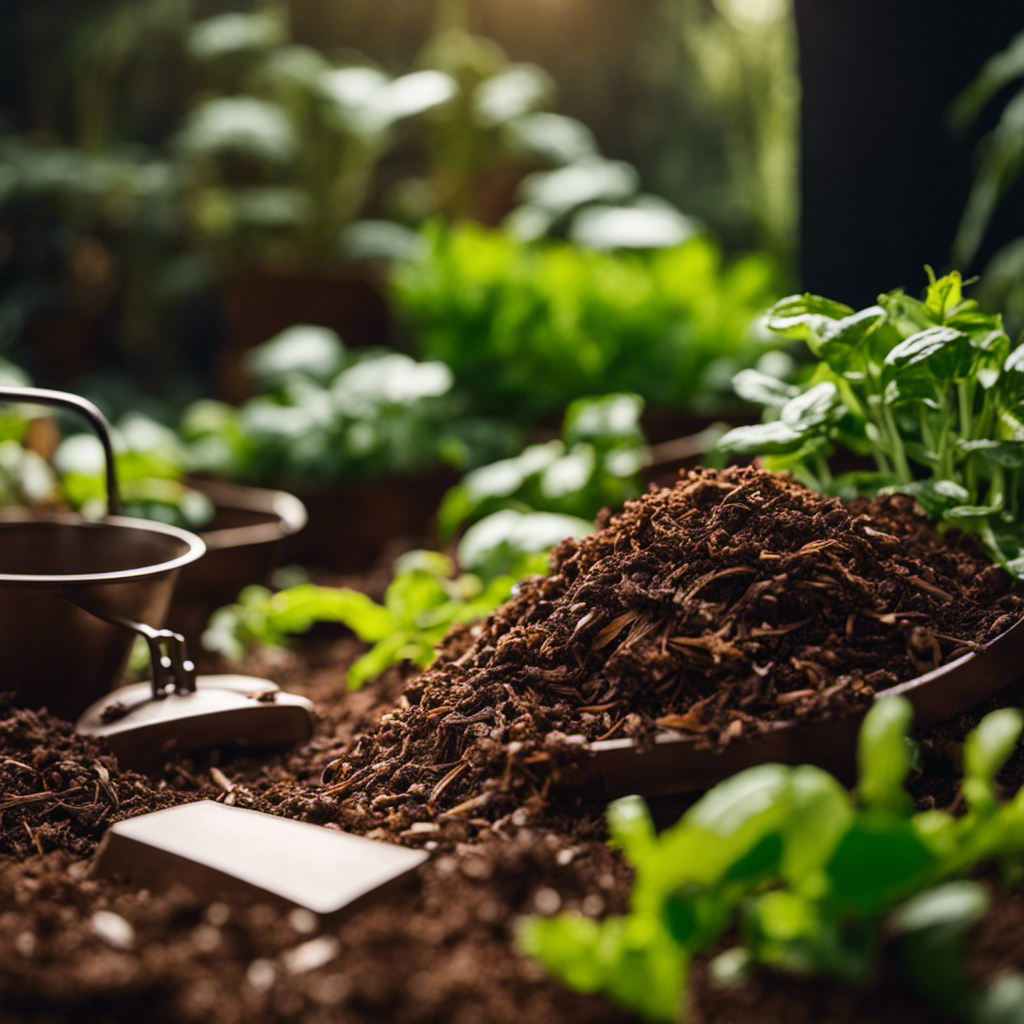
Composting with Shredded Newspaper: A Simple and Cost-Effective Method for Beginners
Composting with shredded newspaper is an effective method that I highly recommend for beginners who are interested in gardening. Shredded newspaper serves multiple purposes in composting and offers various benefits for your plants.
One of the main advantages of using shredded newspaper in composting is its high carbon content. This carbon-rich material helps to balance the nitrogen-rich components in your compost, which is essential for creating healthy and nutrient-rich compost that will nourish your plants.
Another benefit of shredded newspaper in composting is its ability to retain moisture. When added to the compost pile, shredded newspaper acts like a sponge, absorbing and holding onto water. This moisture retention is crucial for the decomposition process and ensures that your compost pile remains hydrated, facilitating the breakdown of organic matter and the growth of beneficial microorganisms.
Apart from its composting benefits, shredded newspaper can also be used as a mulch in your garden. Simply spread a layer of shredded newspaper around your plants to suppress weeds, retain moisture, and regulate soil temperature.
Composting with shredded newspaper is a simple and cost-effective method that provides multiple benefits. It offers carbon-rich material for your compost, helps retain moisture, and aids in weed suppression. Give it a try and witness the thriving of your garden!
Composting With Chicken Manure
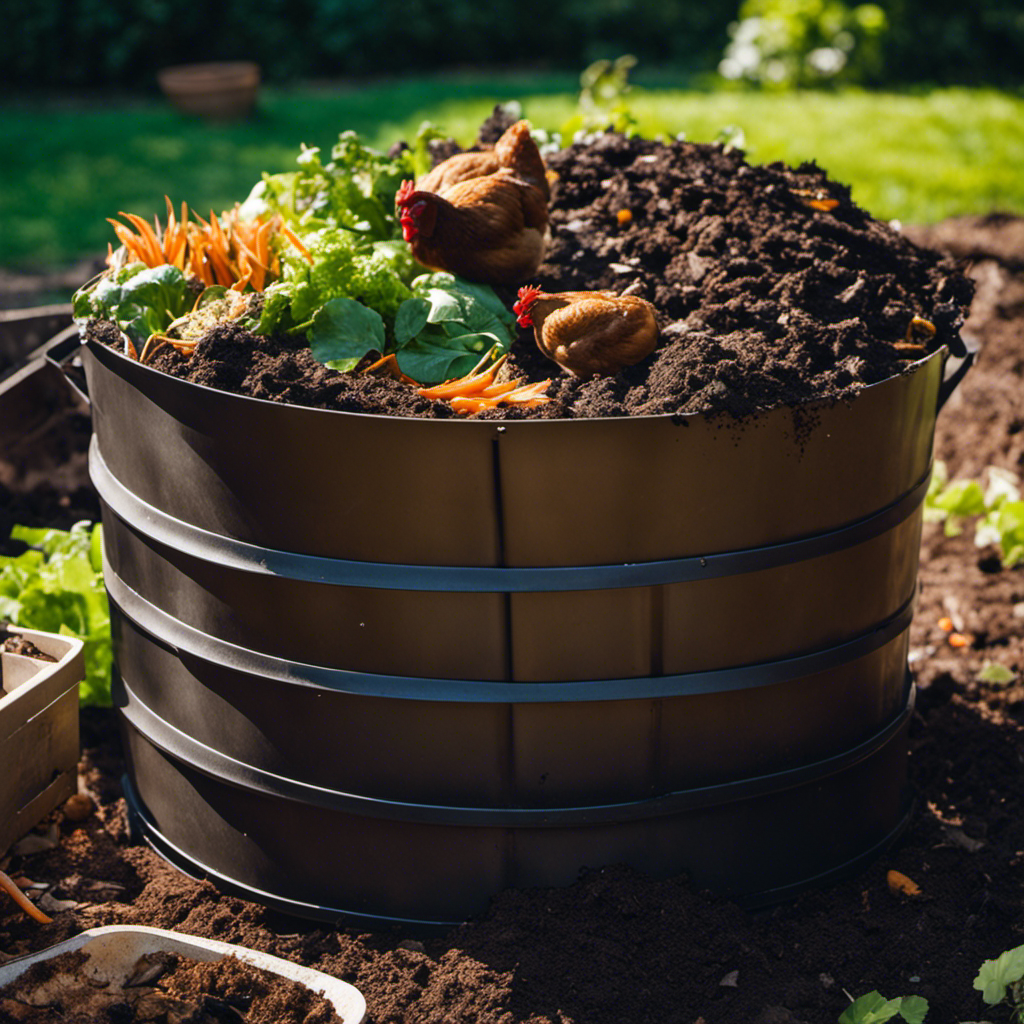
Composting With Chicken Manure
Chicken manure is a valuable addition to your compost pile, providing essential nutrients for healthy plant growth. Here are some benefits and tips for using chicken manure in composting:
-
Nutrient-rich:
Chicken manure is packed with nitrogen, phosphorus, and potassium, which are vital for plant growth. Adding it to your compost pile boosts the nutrient content and improves soil health. -
Enhances soil structure:
The organic matter in chicken manure helps improve soil structure, making it crumbly and easier for plant roots to penetrate. This enhances water infiltration and drainage, reducing the risk of waterlogging. -
Speeds up decomposition:
The high nitrogen content in chicken manure accelerates the decomposition process in your compost pile. This results in faster breakdown of organic materials and the production of nutrient-rich compost. -
Best practices for using chicken manure:
To make the most of chicken manure in composting, follow these practices:- Use aged or composted chicken manure to avoid harming plants with excessive nitrogen.
- Mix chicken manure with other organic materials like dried leaves or straw to maintain a balanced carbon-to-nitrogen ratio.
- Regularly turn the compost pile to ensure proper aeration and decomposition.
- Apply the finished compost to your garden beds or potted plants for healthier and more productive plants.
Composting With Fruit and Vegetable Peels

Composting With Fruit and Vegetable Peels
I often incorporate fruit and vegetable peels into my composting routine to enrich the nutrient content of my compost. Composting with citrus peels and potato peels is a fantastic way to utilize kitchen scraps and reduce waste.
Citrus peels, such as those from oranges, lemons, and grapefruits, contain essential nutrients like potassium, calcium, and magnesium. These nutrients are beneficial for plant growth and can improve the overall health of your compost. To expedite the decomposition process, it’s recommended to chop citrus peels into smaller pieces before adding them to your compost pile.
Potato peels are an excellent source of nitrogen, a vital nutrient for plant growth. Adding potato peels to your compost can increase the nitrogen content and create a well-balanced compost mixture. However, keep in mind that potato peels may take longer to break down compared to other kitchen scraps. To speed up decomposition, you can shred or chop the peels into smaller pieces before adding them to your compost pile.
Remember to always layer your fruit and vegetable peels with other materials like leaves, grass clippings, and shredded paper to maintain a balanced carbon-to-nitrogen ratio. This ensures proper decomposition and prevents any unpleasant odors.
Composting with fruit and vegetable peels not only reduces waste but also produces nutrient-rich compost that nourishes your plants and promotes a healthier garden.
Composting With Yard Waste and Twigs

Composting with yard waste and twigs is an effective method for enhancing your compost pile. Yard waste such as grass clippings, leaves, and small branches can contribute valuable nutrients to your compost. You can break down fallen tree branches into smaller pieces and add them to the compost pile.
Additionally, leaf litter serves as a carbon-rich ingredient that can be used in composting. Incorporating yard waste and twigs into your composting routine is a practical way to nourish your garden and reduce waste.
Benefits of Yard Waste
Benefits of Yard Waste
Using yard waste and twigs in composting offers several advantages for organic gardeners. Here are four reasons why incorporating fallen leaves and mulching with yard waste can greatly benefit your composting efforts:
-
Nutrient-rich compost: Yard waste, like fallen leaves, adds essential nutrients to the compost pile. As they decompose, they release nitrogen, potassium, and phosphorus, which are crucial for promoting healthy plant growth.
-
Improved soil structure: Adding yard waste to your compost helps enhance the structure of the soil. The organic matter in the waste acts as a natural soil conditioner, improving its capacity to retain moisture and nutrients.
-
Weed control: Mulching with yard waste aids in suppressing weed growth in your garden beds. The layer of mulch acts as a barrier, blocking sunlight from reaching weed seeds and inhibiting their germination.
-
Environmental benefits: By composting yard waste, you’re diverting it from landfills, reducing methane emissions, and contributing to a more sustainable and eco-friendly gardening practice.
Incorporating yard waste and twigs into your composting routine is a simple and effective way to enhance the health and productivity of your organic garden.
Utilizing Fallen Tree Branches
Incorporating fallen tree branches into your compost pile is a great way to enhance your composting efforts. Instead of discarding them, repurpose these branches for your garden. Simply cut them into smaller pieces and add them to your compost pile. Over time, the branches will break down and provide valuable nutrients to your compost.
Not only do fallen tree branches have composting benefits, but they can also be used as DIY garden decorations. You can create rustic garden borders, trellises, or use them as plant stakes. This not only adds a unique touch to your garden but also promotes sustainability by reducing waste.
Composting Leaf Litter
Composting Leaf Litter
Composting leaf litter is a simple and effective way to reduce waste and create nutrient-rich compost for your garden. Here are four easy steps to compost leaf litter effectively:
-
Shred the leaves: To speed up the decomposition process, shred the leaves using a lawnmower or leaf shredder. This increases the surface area for microorganisms to break down the leaves.
-
Layer the leaves: Create alternating layers of shredded leaves with other compostable materials like kitchen scraps and grass clippings. This helps maintain a balanced carbon-to-nitrogen ratio in your compost pile.
-
Keep it moist: It’s important to keep the compost pile moist, but not overly wet. Water the pile occasionally to help accelerate the decomposition process.
-
Turn the pile: Every few weeks, use a pitchfork or compost turner to mix and aerate the compost pile. This helps distribute heat and oxygen, promoting faster decomposition.
By following these simple steps, you can transform your yard waste and twigs into nutrient-rich compost that will enrich your garden and reduce landfill waste.
Remember, composting leaf litter is an eco-friendly solution that benefits both your garden and the environment.
[Custom Quote]: ‘Composting leaf litter is a sustainable practice that not only reduces waste but also nourishes your garden naturally.’
Conclusion
Organic composting is a simple and effective way to transform kitchen scraps, yard waste, and other organic materials into nutrient-rich soil for your plants. Instead of using chemicals or artificial fertilizers, you can rely on natural methods to create a healthy environment for your garden.
Two popular composting methods are vermicomposting, which involves using worms, and bokashi composting, which utilizes an airtight container. These techniques help reduce waste and provide a sustainable solution for gardening.
So why not give it a try? With these composting methods, you’ll be on your way to gardening success, like a busy bee pollinating flowers.
